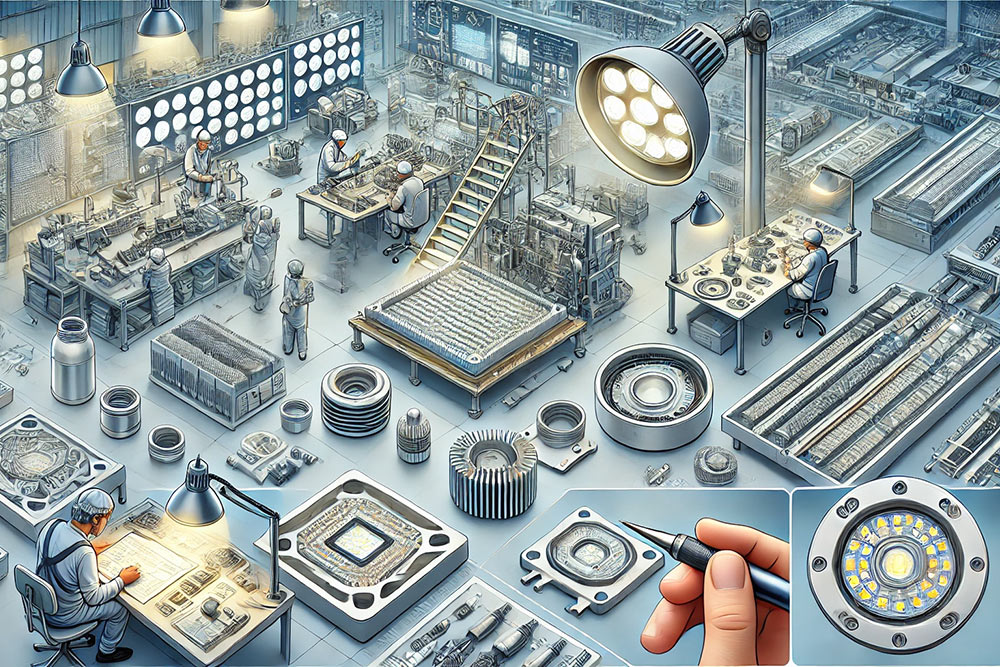Outdoor LED lights have become a staple in modern lighting solutions, offering unmatched energy efficiency, longevity, and durability. These lights are perfect for enhancing gardens, pathways, driveways, and building exteriors. But how exactly are these lights made, and what makes them so effective? Let’s take a closer look at the fascinating process of manufacturing outdoor LED lights and how they work.
Material Selection: The First Step
The journey of an outdoor LED light begins with the careful selection of high-quality materials. The key components include LED chips, heat sinks, drivers, housings, and lenses. The quality of these materials is crucial as it directly impacts the performance and durability of the final product. Manufacturers source the best materials to ensure that the LED lights can withstand the harsh outdoor conditions they will face.
Creating the LED Chip
At the heart of every LED light is the LED chip. This small but mighty component is where the magic happens. The production of an LED chip starts with a substrate, usually made of sapphire or silicon carbide. Layers of semiconductor materials are deposited on this substrate through a process known as epitaxy. This creates a thin film that forms the active region of the LED.
Once these layers are in place, the substrate is sliced into individual LED chips. These chips undergo rigorous testing to ensure they meet quality and performance standards before they are packaged. Packaging involves attaching the LED chip to a heat-conducting base and encapsulating it with a protective lens, making the chip ready for the next stage of production.
Managing Heat with Heat Sinks
One of the critical aspects of LED lighting is heat management. Unlike traditional bulbs, LEDs don’t emit much heat, but the heat they do produce needs to be managed effectively to maintain performance and longevity. This is where heat sinks come into play. Typically made from aluminum, heat sinks are designed to absorb and dissipate heat away from the LED chip. They are fabricated through processes like extrusion, machining, and anodizing to enhance their thermal conductivity.
Powering the LED: The Driver
The LED driver is another essential component. It converts the incoming electrical power to the correct voltage and current needed by the LED chip. The driver assembly involves selecting high-quality electronic components, such as capacitors and transformers, and assembling them on a printed circuit board (PCB). This PCB is then encased in a protective housing to shield it from environmental factors, ensuring the LED light operates efficiently and safely.
Housing and Lenses: Protection and Focus
The housing of an LED light protects the internal components from dust, moisture, and mechanical damage. It is typically made from durable materials like aluminum or high-grade plastic. The lenses, made from polycarbonate or glass, focus and direct the light emitted by the LED chip. These lenses are designed to provide specific beam angles and light distribution patterns, which is crucial for creating the desired lighting effect.
Bringing It All Together
In the final assembly stage, all these components come together. The LED chip is mounted onto the heat sink, and the driver is connected to the chip. The entire assembly is then enclosed in the housing, with lenses placed over the LED chip to direct the light. Once assembled, the LED light undergoes thorough testing to ensure it meets all performance and safety standards. This rigorous process ensures that each light is ready to deliver reliable and efficient illumination.
How Outdoor LED Lights Work
Now that we’ve explored how outdoor LED lights are made, let’s delve into how they work. The operation of an LED light involves several key principles and components. At its core, an LED (Light Emitting Diode) is a semiconductor device that emits light when an electric current passes through it. This process, known as electroluminescence, occurs when electrons in the semiconductor material gain energy and move to a higher energy state. As these electrons return to their original state, they release energy in the form of photons, which is the light we see.
Heat management is crucial for LEDs, and this is where the heat sink plays a vital role. It absorbs and dissipates the heat produced by the LED chip, preventing overheating and ensuring the light maintains its performance and longevity. The lenses and reflectors in the LED light fixture also play an essential role by directing and distributing the light. They focus the light into a narrow beam for spot lighting or diffuse it for broader coverage, depending on the application.
The LED driver is responsible for converting the incoming AC power from the mains supply to the DC power required by the LED chip. It also regulates the voltage and current to ensure consistent light output and protect the LED from power surges. This makes the driver a critical component that influences the overall efficiency and lifespan of the LED light.
The Advantages of LED Lighting
The manufacturing process and working principles of LED lights result in several advantages over traditional lighting technologies. LED lights are incredibly energy-efficient, consuming significantly less power compared to incandescent and fluorescent lights. This not only reduces energy bills but also minimizes environmental impact. LEDs also have a much longer lifespan, often exceeding 50,000 hours of operation, which reduces the frequency and cost of replacements.
Durability is another major advantage. LEDs are more robust and resistant to shock, vibration, and extreme temperatures, making them ideal for outdoor use. They are also eco-friendly, as they do not contain harmful substances like mercury and have lower carbon emissions, contributing to a greener environment.
The journey of an outdoor LED light from manufacturing to illumination involves sophisticated processes and advanced technology. The result is a highly efficient, durable, and versatile lighting solution that enhances the beauty and safety of outdoor spaces. By understanding the manufacturing process and working principles of LED lights, we can better appreciate the innovation and craftsmanship that go into creating these modern lighting marvels. Whether you’re looking to illuminate your garden, pathway, or building exterior, LED lights offer a superior lighting experience that stands the test of time.


